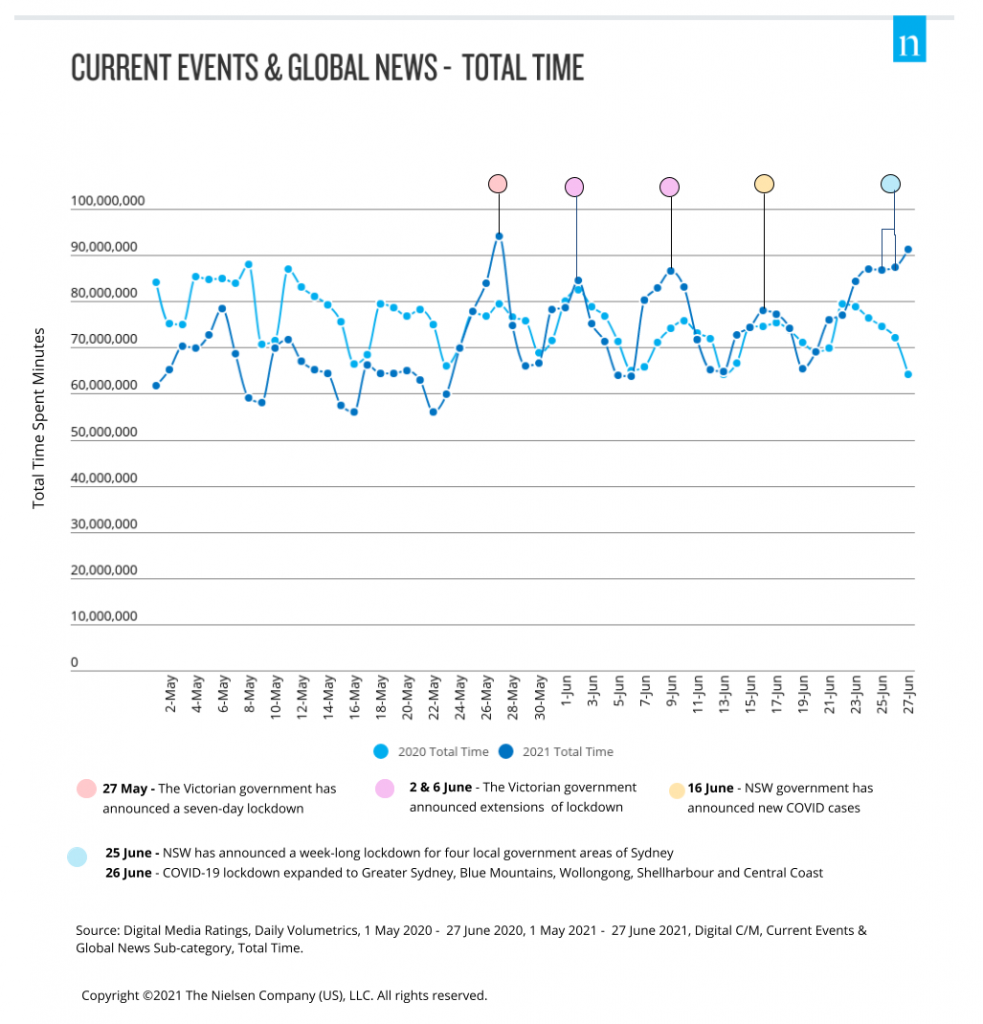Even though the news is continually changing and digital consumption habits continue to evolve, over the last 18 months in particular we have seen some interesting trends in relation to the types of news content being consumed, formats being consumed, where it is being consumed and the funding models underlying the news business.
According to Nielsen, in 2021, on average 80% of adult Australians turned to digital news sites and apps to stay informed and updated every month. Traffic levels to news websites apps remains high and peaks are generally still linked to COVID-19 news and announcements. They noted that Total Time Spent recorded its peak on May 27, 2021, reaching 1.6 million hours when the Victorian government announced a seven-day lockdown, the second highest was recorded on June 27, 2021, reaching 1.5 million hours as NSW went into the first day into lockdown. (source: Nielsen press release June 29th 2021)
We asked a couple of our member organisations to provide some background on recent media consumption trends and what it means for marketers. Thanks to BBC World News and The Guardian Australia for their thoughts below.
Jamie Chambers, Vice President ANZ, BBC World News & BBC.COM
Obviously traffic to different news topics and categories has fluctuated over the last 18 months, but are there any new categories or topics that have significantly grown and sustained interest over this period?
While many news publishers have recorded traffic growth in 2020, perhaps our most interesting stories have come from our business audience, and topics relating to the environment and sustainability.
A report published in Dec 2019 by KPMG* noted Australian business leaders were more concerned with the risks posed by global forces than domestic. Events of 2020 showed these concerns to be prescient as climate change (bushfires), global trade (China) and then the pandemic all had devastating impacts on businesses and society at large. As a result, rather than relying on domestic publications, business leaders are increasingly coming directly to global publishers like BBC.com for news on global issues. On BBC.com, business audiences growth outpaced our overall audience growth by 28% and visit frequency and duration are higher than average, showing just how important BBC.com has become for this audience.
The past 18 months have also seen public concern for climate issues come to the fore. In Australia, this has become a highly politicised topic and coverage has been affected by domestic media bias, meaning audiences have been left searching for news they can trust. BBC News’ reputation as an impartial source of global news has likely contributed to the traffic surges we’ve seen in this space.
In response to these signals, our commissioning strategies have changed resulting in new editorial platforms. In 2020, we launched new business news sections, ‘New Economy’ and ‘New Tech Economy’, and ‘BBC Future Planet’ – our new feature site section dedicated to solutions-focused environmental journalism – has quickly grown to become our biggest feature site section.
What’s clear is concern for global issues and their impact on Australian shores are leading audiences to BBC.com as a primary source of global news, and in turn, we are adjusting our commissioning strategy to meet this audience demand.
Adam Axiak, Head of Audience, The Guardian Australia
Have there been any recent changes in the way that marketers and agencies are looking at the opportunity to reach consumers in news environments?
Compared to just a few years ago, Australians have become more mindful and passionate about the consolidation of news and social issues. They’ve become more vocal and empowered by seeking ways to make a more purposeful difference. This has reflected not only through Australia but in other markets around the world.
Australians are making a conscious effort to address these environmental or societal issues, from correctly sorting their recycling through to stocking communal food pantries to help the less fortunate. There is a genuine rise in people walking-the-walk and committing in taking action.
As many are striving to become better global citizens, they are increasingly expecting the same mindset from the brands they purchase and consume. In a survey we conducted recently, 84% of our readers agreed that there is greater expectation for corporations to be socially or environmentally responsible now compared to five years ago and 90% said that this expectation will grow into the future. Consumers are increasingly looking for more than just price, range or product features, they want to be associated with brands that are actively making a difference in the world and empower consumers along their journey.
Australians are also becoming much more media savvy. Whilst some news consumption revolves around that utilitarian need for updates such as COVID-19 numbers or who will be the half-back to replace Nathan Cleary in the State of Origin, many Australian’s are turning to news brands that publish content around the issues that strike a chord with their own worldview. In many ways, I think Australians identify themselves by the news publications they consume.
Whether a brand or product is ethically sourced, environmentally friendly or striving for equality, marketers are adapting and increasingly associating with news environments that tap into this progressive audience that their purposeful message resonates with. I think this will be a big trend in years to come.

